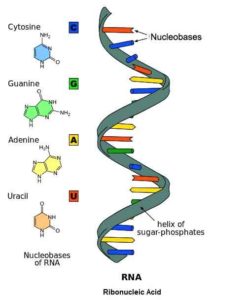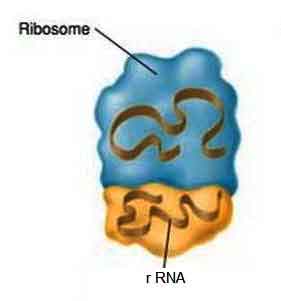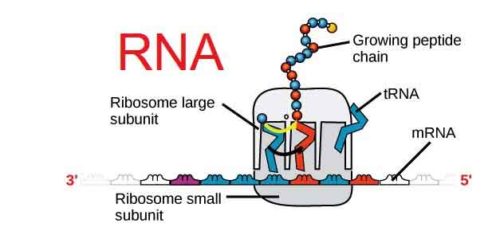Johannes Friedrich Miescher (a Swiss physician and biologist) first discovered the Nucleic acids as ‘nuclein’ from the nucleus in 1869. Severo Ochoa de Albornoz (a Spanish-American physician and biochemist) discovered the RNA synthesis mechanism in 1959. He won the Nobel Prize jointly with Arthur Kornberg in Physiology or Medicine for his discoveries. In 1965, Robert W. Holley sequences 77 nucleotides of yeast tRNA.
Ribonucleic acid or RNA is an essential biological macromolecule. Generally, it helps to exchange the hereditary information encoded by DNA into proteins. The nucleic acid of living cell having ribose sugar in its nucleotides and perform multiple vital roles in the coding, decoding, regulation and expression of genes is called Ribonucleic acid or RNA.
In prokaryotic cell these are found in cytoplasm, chromosome, ribosome, nucleolus, plastid and mitochondria. In eukaryotic cells, 90% RNA present in cytoplasm and 10% in other structures. In some virus, RNA exists as genetic material.
Physical Structure of RNA
Primarily RNA is single-stranded particle with an intra-strand pairing yet in their secondary structure; there are a few U shaped loops. It can show a broad twofold helical structure and can also form different tertiary structures.

Chemical Structure of RNA
RNA molecule is a polymer of ribonucleotide. Each ribonucleotide consists of the following molecules:
- One molecule of ribose pentose sugar,
- One molecule of inorganic phosphoric acid and
- One molecule of nitrogenous base.
Each nucleotide in a RNA molecule has one of four nitrogenous bases: adenine, guanine, cytosine and uracil. The first two are purine and the later two are pyrimidine bases.
Types of RNA
RNA is of two main types, such as:
1. Genetic RNA or gRNA: When RNA functions as genetic materials then it is known as genetic RNA, e.g. RNA of some viruses.
2. Non-genetic RNA: When RNA takes part in only protein synthesis, then it is called non-genetic RNA, e.g. RNA of eukaryotic and prokaryotic cells.
Non-genetic RNA is further divided into the following three types:
- Ribosomal RNA or rRNA
- Messenger RNA or mRNA
- Transfer RNA or tRNA
Ribosomal RNA or rRNA: It makes up about 80% of the total RNA in a cell. These are synthesized in nucleolus and occur in ribosome, the protein factories of the cells. Ribosomal RNA is composed of unbranhed, flexible polynucleotide chain. This chain remains coil in low ionic concentration but its nitrogen bases form helical part in high ionic concentration. In such case, adenine bound with uracil and guanine bound with cytosine.
Eukaryotic rRNA is of four types: 28S rRNA, 18S rRNA, 5.8S rRNA, and 5S rRNA.

Image showing Ribosomal RNA (rRNA)
Functions of rRNA
- Ribosomal RNA gives a procedure for decoding mRNA into amino acids and interrelates with tRNAs during translation.
- It comprises the predominant material within the ribosome. During protein synthesis.
- It guarantees the proper alignment of tRNA, mRNA, and ribosome.
- It catalyzes during peptide bond formation between amino acids.
Messenger RNA or mRNA
French scientists François Jacob and Jacques Monod coined the name mRNA in 1961. mRNA is a single-strand made of up to several thousand nucleotides. It is created as complementary strand of DNA hence it has base sequences as like as in DNA. In its linear structure, mRNA has two non-coding ends and middle coding zone. The two ends of mRNA recognized as 5´ leader and 3´ trailer end. mRNA makes up 3-5% of the total RNA in a cell.
mRNA is a copy of the hereditary information produced by transcription from the cell’s original blueprint, DNA. This hereditary information is brought to the protein factories of the cells, ribosome for using as instruction for the formation of proteins.

Image showing mRNA
Functions of mRNA
- mRNA is transcribed from the DNA template in the nucleus and carries coding information to the sites of protein synthesis in the ribosomes.
Transfer RNA or tRNA
Transfer RNA is also known as tRNA. It is a small and clover leaf shape RNA which helps transmission a specific amino acid to a new polypeptide chain. During translation, this transmission occurs at the ribosomal site of protein synthesis.
In this case, each of the 20 amino acids which have a specific tRNA that binds with it to form proteins. The tRNA is made up of 70 to 95 nucleotides. It is the essential component of translation and it performs to transfer of amino acids during protein synthesis as a main functions. Hence, it is called transfer RNA or tRNA. tRNA is also called adaptor molecules because it acts as adaptor in the transformation of the genetic sequence of mRNA into proteins. Sometimes tRNA ia also called soluble, or activator RNA.
Robert Willium Holley et al. (1965) proposed the clover leaf model structure of tRNA. He awarded the Nobel Prize in Physiology or Medicine in 1968 with Har Gobind Khorana and Marshall Warren Nirenberg for describing this model. According to this model the single polynucleotide chain of tRNA is folded upon itself to form five arms. The arms are:
- Acceptor arm
- Dihydrouridine (DHU) arm or D arm
- Anticodon arm
- Variable arm and
- Thiamine psedocytosine or TΨC arm.
tRNA also have DHU loop, variable loop, anticodon loop, T-loop or TΨC loop and amino acid acceptor end. It has four normal bases A, G, U, C and some unknown bases like isonine (I), dihydouridine, psedouradine, etc. Both end of single chain of tRNA (5´-3´) exist aside.

Image showing Clover Leaf Model Structure of tRNA
Functions of tRNA
- It identifies and transports the correct amino acid molecules to the site of protein synthesis in the ribosome.
- It primarily is familiar for carrying amino acids.
- It also takes part in the process of building proteins.
RNAa can also be broadly divided into the following types:
- Coding (cRNA) and
- Non-coding RNA (ncRNA)
Non-coding RNAs (ncRNA) are of the following two types, such as:
- Housekeeping ncRNAs (tRNA and rRNA) and
- Regulatory ncRNAs.
Non-coding RNA (ncRNA) is further divided into the following two types based on their size such as:
1. IncRNA or Long ncRANS: As a minimum, 200 nucleotides are present in IncRNA.
2. Small ncRNAS: Less than 200 nucleotides are present in ncRNAS.
Small ncRNAs are subdivided into the following five types:
1. miRNA: It is also called micro RNA
2. snoRNA: It is also known as small nucleolar RNA
3. snRNA: It is also known as small nuclear RNA
4. siRNA: It is also called small-interfering RNA
5. piRNA: It is also called PIWI-interacting RNA
The size of the miRNAs is about twenty two (22) nucleotides long and have particular importance. In most eukaryotic cells, they perform to function in gene regulation. Some miRNAs can regulate target genes which lead to tumour progression and tumorigenesis. The size of piRNA is about 26-31 nucleotide long. They are present in most animals. They can regulate the expression of jumping genes or transposon that move from one location to another on a chromosome. These genes were first identified by Barbara McClintock.
Concluding Remarks
Definitively, the RNA is as significant as DNA into molecular investigations as the evaluation of the gene expression is relies upon the complete mRNA present into the specific tissue. mRNA is fundamental to the procedure of transcription, while tRNA is essential to the procedure of translation, and rRNA makes up the ribosomes in which translation occurs. The amount of expression of gene can be estimated by utilizing the Reverse transcription polymerase chain reaction technique or RT-PCR technique through the evaluation of RNA.

